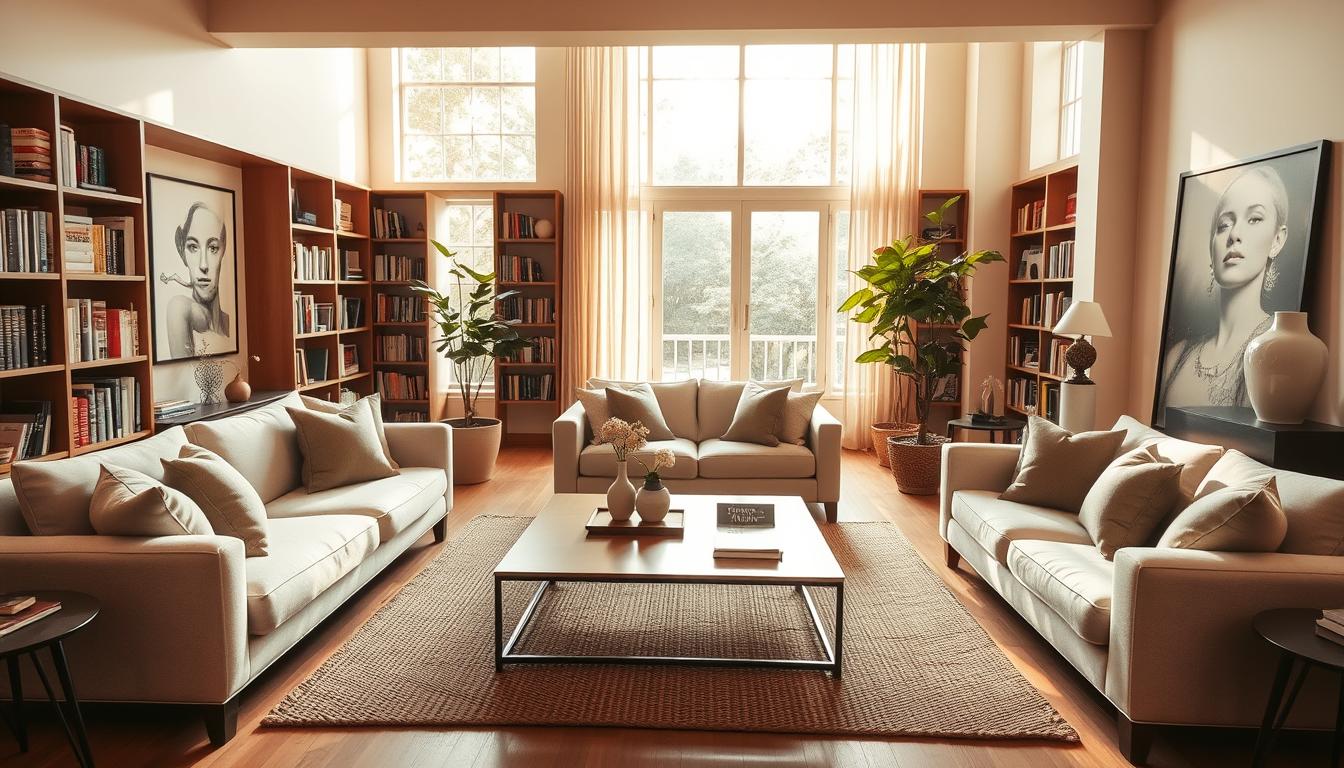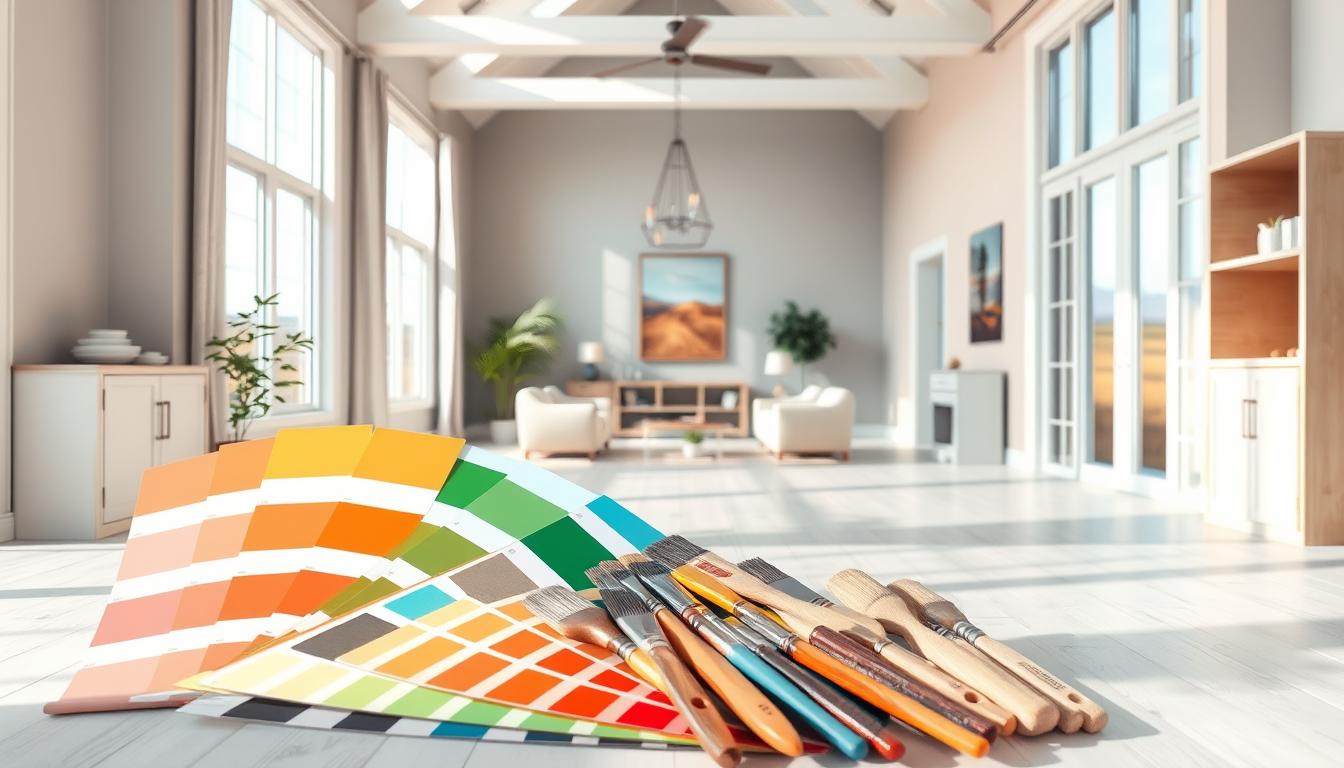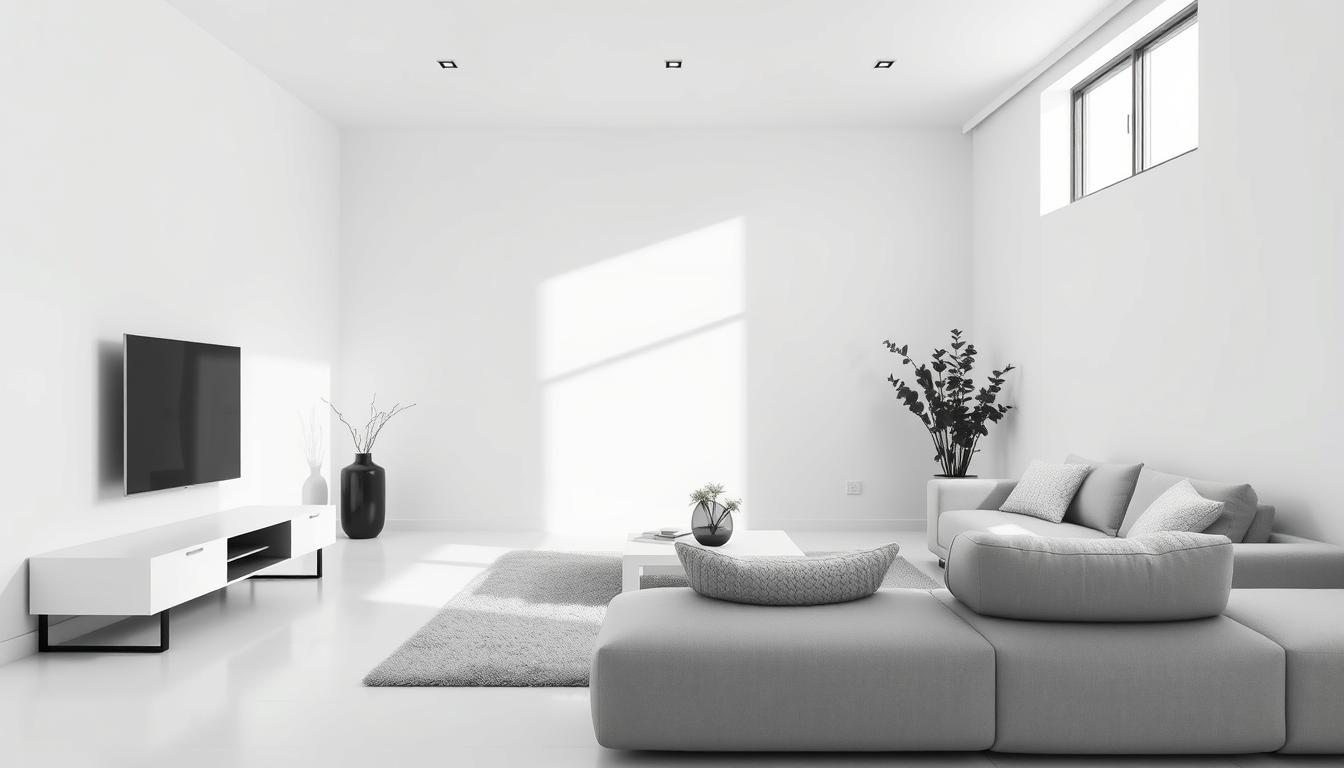Did you know a well-designed home interior can boost a property’s value by up to 15%? With design trends always changing, it’s key to keep up with the latest styles. These can make your living space look amazing. You can find inspiration in lighting, furniture, and colors.
We’ll dive into the top 10 ideas for home interior design. These ideas are both stylish and practical. They’ll help you create a stunning space that shows off your personal style.
Key Takeaways
- Top 10 home interior design ideas for a stunning living space
- Timeless design elements that never go out of style
- Modern twists on classic decor
- The importance of staying updated on the latest design trends
- How to create a functional and stylish home
Embracing Minimalism for a Clean Look
Minimalism in interior design focuses on clean lines and less clutter. It promotes simplicity and function, making homes more organized and peaceful.
Minimalist design aims for a calm, uncluttered, and beautiful space. It uses neutral colors, functional furniture, and soft textures to achieve this.
Benefits of Minimalist Design
Minimalist design brings many benefits, like less clutter, more calm, and better focus. By keeping only the essentials, your space becomes serene and less busy.
Key Benefits:
- Reduced visual clutter
- Increased sense of calm
- Improved focus and productivity
- Easier maintenance and cleaning
| Benefit | Description |
|---|---|
| Reduced Clutter | Minimalist spaces have fewer items, reducing visual clutter. |
| Increased Calm | A clutter-free environment promotes a sense of calm and relaxation. |
| Improved Focus | With fewer distractions, minimalist spaces can improve concentration. |
Tips for Achieving a Minimalist Space
To get a minimalist space, start by getting rid of unnecessary items. Choose furniture that serves more than one purpose. Use neutral colors and soft textures for a clean, elegant look.
Here are some practical tips:
- Declutter regularly to maintain a clutter-free environment.
- Choose multi-functional furniture pieces.
- Opt for a neutral color palette.
- Use subtle textures to add depth without clutter.
Incorporating Nature through Biophilic Design
As cities grow, adding nature to our homes is key for our health. Biophilic design, which connects us to nature, is becoming a popular way to decorate homes.
What is Biophilic Design?
Biophilic design aims to link us back to nature. It uses natural materials and elements to make homes better for us. This design not only looks good but also helps us feel better by reducing stress and improving air quality.
It includes using wood, stone, and bamboo for furniture and floors. Adding plants and lots of natural light are also important. These elements make our homes feel more natural and connected to the outdoors.
Plants That Thrive Indoors
Plants are vital in biophilic design. They clean the air and make our homes look beautiful. Some top indoor plants are Snake Plants, Spider Plants, and Peace Lilies. They are easy to care for and clean the air well.
| Plant Type | Maintenance Level | Air Purifying Qualities |
|---|---|---|
| Snake Plant | Low | High |
| Spider Plant | Low | Medium |
| Peace Lily | Medium | High |
Ideas for Natural Light Integration
Bringing in more natural light is a big part of biophilic design. We can do this with large windows, skylights, and mirrors. This makes our homes brighter and more welcoming.
Some creative ways to add natural light include a glass roof or light tubes. These help light up even the darkest parts of our homes, making them feel more inviting.
The Power of Color in Home Interiors
In 2025, color is making a big comeback in home decor. It changes the feel of a room, making it key in design. The right colors can show off your style, improve your mood, and make you feel better.
Choosing the Right Color Palette
Finding the perfect colors for your home can be hard. Think about the light in your rooms. More light means you can use bolder colors. Less light calls for lighter shades to brighten up the space.
Also, think about what the room is for. Bedrooms need calming colors like blue or green. Living rooms can use warm colors like orange or yellow to get people talking.
| Room Type | Recommended Colors | Effect |
|---|---|---|
| Bedroom | Soft Blues, Greens | Promotes Relaxation |
| Living Room | Warm Oranges, Yellows | Encourages Social Interaction |
| Study/Office | Focused Reds, Neutrals | Enhances Concentration |
Impact of Color on Mood
Colors affect our feelings and mood. Knowing how different colors make us feel helps in choosing colors. For example, blue makes us calm, great for bedrooms.
Red boosts energy, perfect for lively areas like dining rooms or gyms.
Accent Walls: Making a Statement
Accent walls are a great way to add color and focus in a room. A bold color on one wall adds depth and interest. This works well with neutral colors, making the accent wall stand out.
When doing accent walls, match the color with your furniture. A well-chosen accent wall can transform a room into something amazing.
Using color wisely in your home can make it look better and feel better. Whether you’re updating one room or your whole house, color is a powerful tool.
Custom Furniture Solutions for Unique Spaces
In the world of home decor, custom furniture unlocks your space’s full potential. You can make pieces fit your exact needs, making your home stylish and useful.
Designing furniture for your home involves several key factors. You want pieces that look good and work well. At West of Main Design, we focus on both looks and function.
Designing for Functionality and Aesthetics
Good custom furniture design starts with knowing your space and needs. It’s about making pieces that fit your decor and fill any gaps. For example, a storage ottoman can hold clutter and add seating.
Think about your home’s style and era when choosing furniture. A farmhouse might need rustic wood, while a modern place might want sleek designs.
Options for Upcycling Old Furniture
Upcycling old furniture is budget-friendly and eco-friendly. You can give old pieces a new life by painting, reupholstering, or changing their use.
- Turn an old ladder into a unique bookshelf.
- Reupholster a vintage armchair to give it a modern twist.
- Convert an antique dresser into a kitchen island.
Custom Shelving Ideas
Custom shelving adds storage and display space. It can fit any room, tailored to your needs.
Some ideas include:
- Floating shelves for a minimalist look.
- Corner shelves to maximize often-wasted space.
- Built-in shelving for a seamless look with your walls.
Adding custom furniture to your decor makes your space truly yours. Whether you’re upcycling or starting fresh, the options are endless.
Smart Technology for Modern Interiors
Smart technology is changing how we design our homes. It brings together new ideas that make our lives easier and our homes look better. This technology is not just about convenience; it also adds style to our living spaces.
Home Automation Essentials
Home automation is key to smart technology. It lets us control our homes easily. Automated lighting, thermostats, and security systems make our homes more comfortable and safe. These systems work together to make our lives smoother.
For example, smart thermostats adjust the temperature based on our preferences. Automated lighting turns on or off at set times. These features improve our comfort and help save energy.
Integrating Smart Lighting Solutions
Smart lighting is important in modern home design. It changes how we feel and work. Smart bulbs and LED strips can be controlled remotely or set to match any mood.
Smart lighting also works well with other smart devices. It can be linked to security systems to make it seem like someone is home when we’re not. This adds an extra security feature.
Smart technology lets us create homes that are both stylish and practical. As technology gets better, we’ll see even more ways to improve our living spaces.
Layering Textures for Depth and Interest
To add depth and interest to your home decor, consider layering textures. This creative idea makes your space more inviting and stylish. By using different textures, you can create a cozy and visually appealing atmosphere.
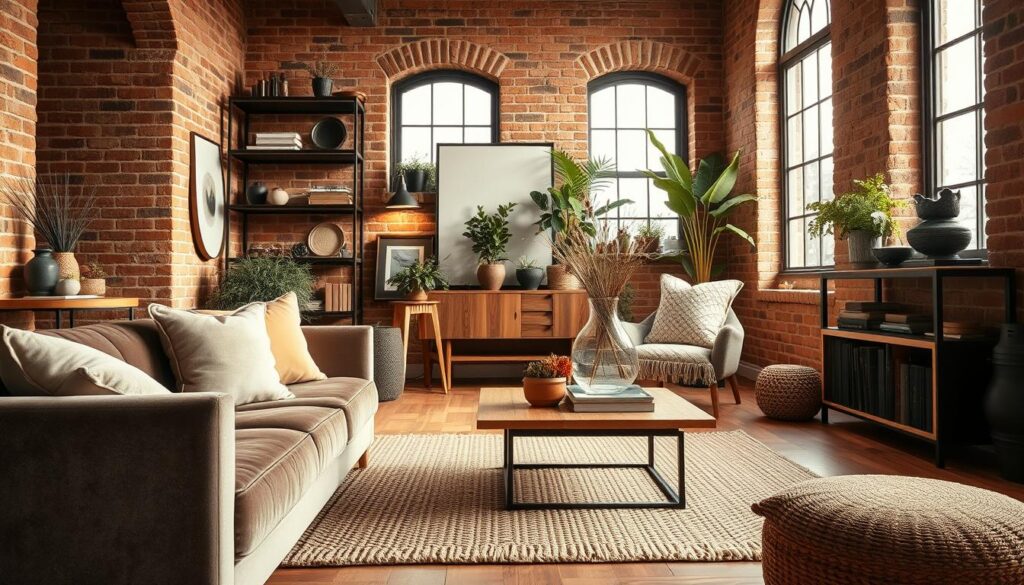
Textiles: Fabrics that Enhance Comfort
Textiles are key to making a room comfortable. Soft fabrics like velvet, linen, and cotton add warmth and coziness. Use throw blankets, rugs, and pillows in various textures for a layered look.
For example, a smooth leather sofa paired with a chunky woven blanket creates a nice contrast. Adding a plush area rug to a room with hardwood floors makes it warmer underfoot.
“The tactile experience of different textures can greatly impact the ambiance of a room.”
Combining Hard and Soft Elements
Combining hard and soft elements is essential for a balanced look. Hard elements like metal, glass, and wood offer a sleek, modern contrast to soft textiles. For instance, a glass coffee table can complement a soft, oversized sectional sofa.
To mix these elements, start with a dominant texture, like a soft sectional sofa. Then, add contrasting textures, such as a metal side table or a wooden coffee table. This mix creates visual interest and depth.
- Mix different materials like wood, metal, and glass.
- Incorporate a variety of fabrics through throw pillows, blankets, and rugs.
- Balance hard elements with soft textiles.
By layering textures and combining hard and soft elements, you can create stylish home decor. It will be both inviting and visually appealing.
Artistic Touches: Personalizing Your Space
Adding artistic touches to your home makes it a true reflection of you. By using elements that show your style, your space becomes uniquely yours. At Satori Loka, we think your home should be a canvas for your creativity and individuality.
Displaying Art and Personal Collections
Displaying your art and collections is a great way to add an artistic touch. This could include vintage items, artwork, or sentimental trinkets. The goal is to arrange them in a way that tells a story or brings out a certain feeling.
- Use shelves or display cases to showcase your items.
- Group similar items together to create a cohesive look.
- Experiment with different heights and textures to add visual interest.
DIY Art Ideas for Creativity
Making your own art is a fun way to personalize your space. Here are some DIY art ideas to start with:
| Project | Materials | Description |
|---|---|---|
| Abstract Canvas | Canvas, paint, brushes | Create a unique piece of abstract art using different colors and techniques. |
| Photo Collage | Photos, frame, glue | Make a collage of your favorite memories and frame them for a personal touch. |
| Mosaic Art | Tiles, adhesive, grout | Create a mosaic piece using tiles and add it to your wall or tabletop. |
By adding these artistic touches, you can make your home truly reflect your personality and style. Whether it’s through displaying collections or making your own art, the options are endless. Remember, your home is your canvas, and you are the artist.
Open Floor Plans: Maximizing Space and Light
Open floor plans are a hit in modern homes for their spacious feel. They merge living areas, making the home feel bigger. This design also boosts interaction between family and guests.
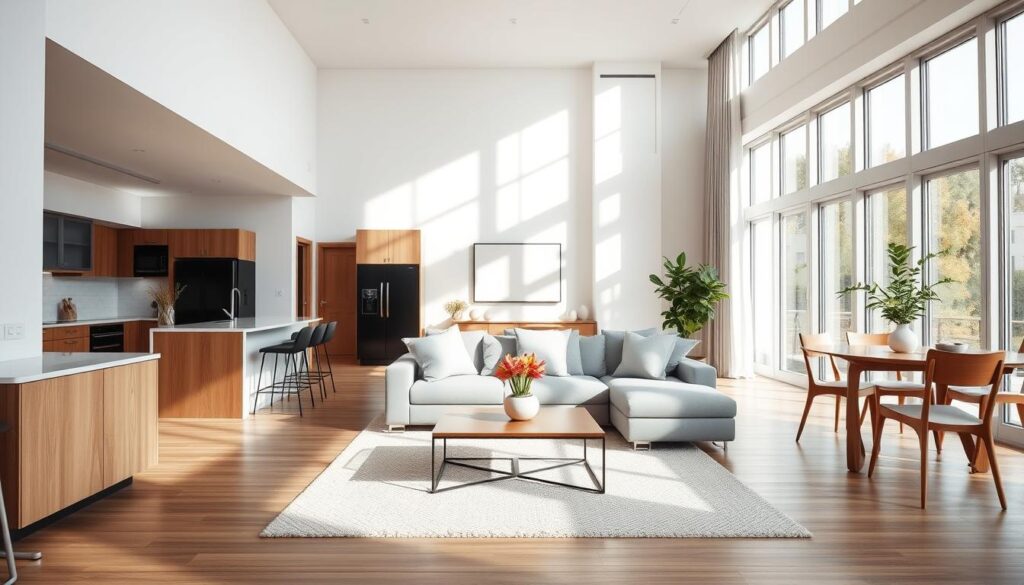
Benefits of Open Concept Living
Open concept living brings many perks. It makes the home feel larger and improves family and guest interaction. Plus, it lets natural light flow better, making the home brighter and more inviting.
- Increased Sense of Spaciousness: Removing walls makes the home feel more open and airy.
- Improved Interaction: Open floor plans help family and guests communicate better.
- Better Natural Light Flow: With fewer walls, natural light moves more freely around the home.
Tips for Defining Spaces
Open floor plans are great but can make it hard to define different areas. Here are some tips to help:
- Use Area Rugs: Area rugs can mark off spaces, like a living area or dining space.
- Partial Dividers: Half-walls or shelving units can separate areas without blocking them off.
- Furniture Placement: Place furniture smartly to create clear areas within the open floor plan.
With these tips, homeowners can enjoy open floor plans while keeping different spaces defined.
Sustainable Design Practices for a Greener Home
We all want to live in a way that’s better for our planet. Sustainable design is key to making our homes more eco-friendly. By choosing the right materials and energy-saving solutions, we can make a big difference.
Materials for a Sustainable Home
Using materials like reclaimed wood, bamboo, and natural fabrics helps our homes be greener. For example, LED bulbs use much less electricity and last longer than old bulbs. Also, choosing wood and textiles that are certified helps reduce harm to the environment.
To learn more about making your home eco-friendly, check out Decorilla’s guide to eco-friendly design.
Energy Efficiency in Home Interiors
Energy efficiency is crucial for a sustainable home. Using appliances with the Energy Star label saves a lot of power and water. Also, paints that don’t release harmful fumes help keep our air clean.
By choosing these options, we can decorate our homes in a way that’s both stylish and good for the planet. And it doesn’t have to cost a lot.

